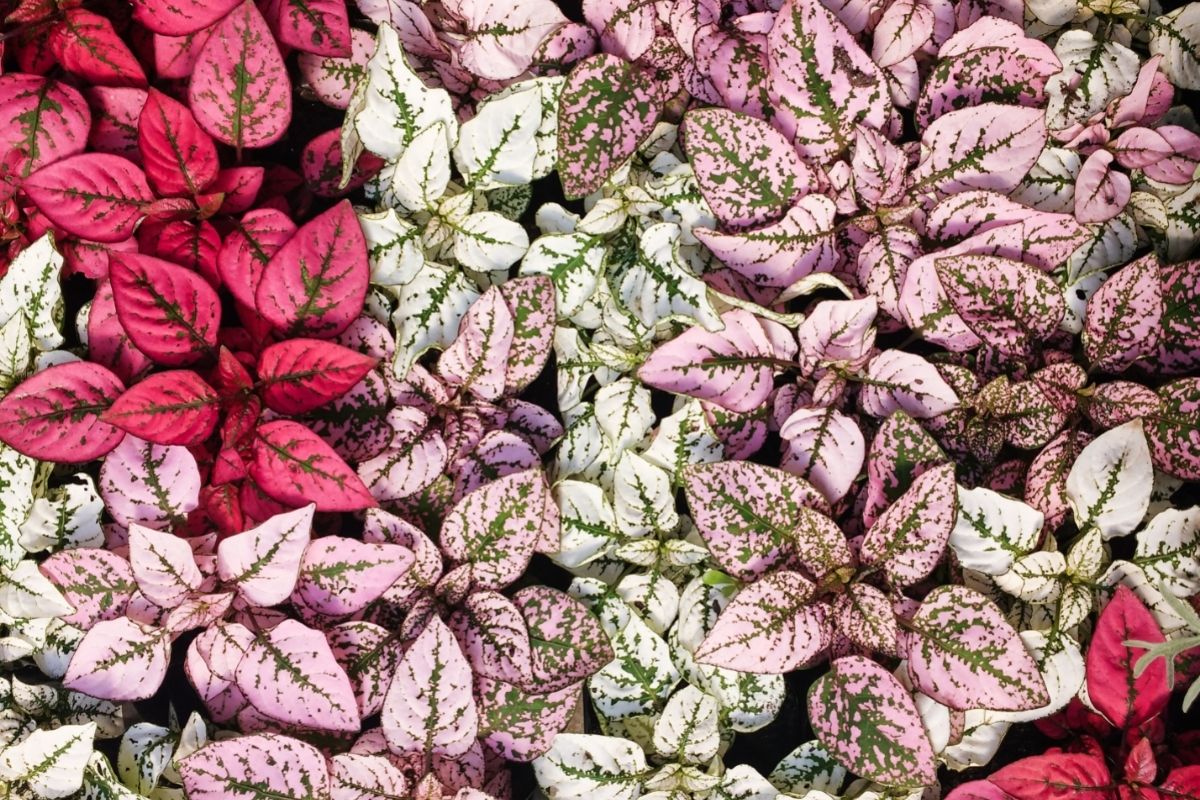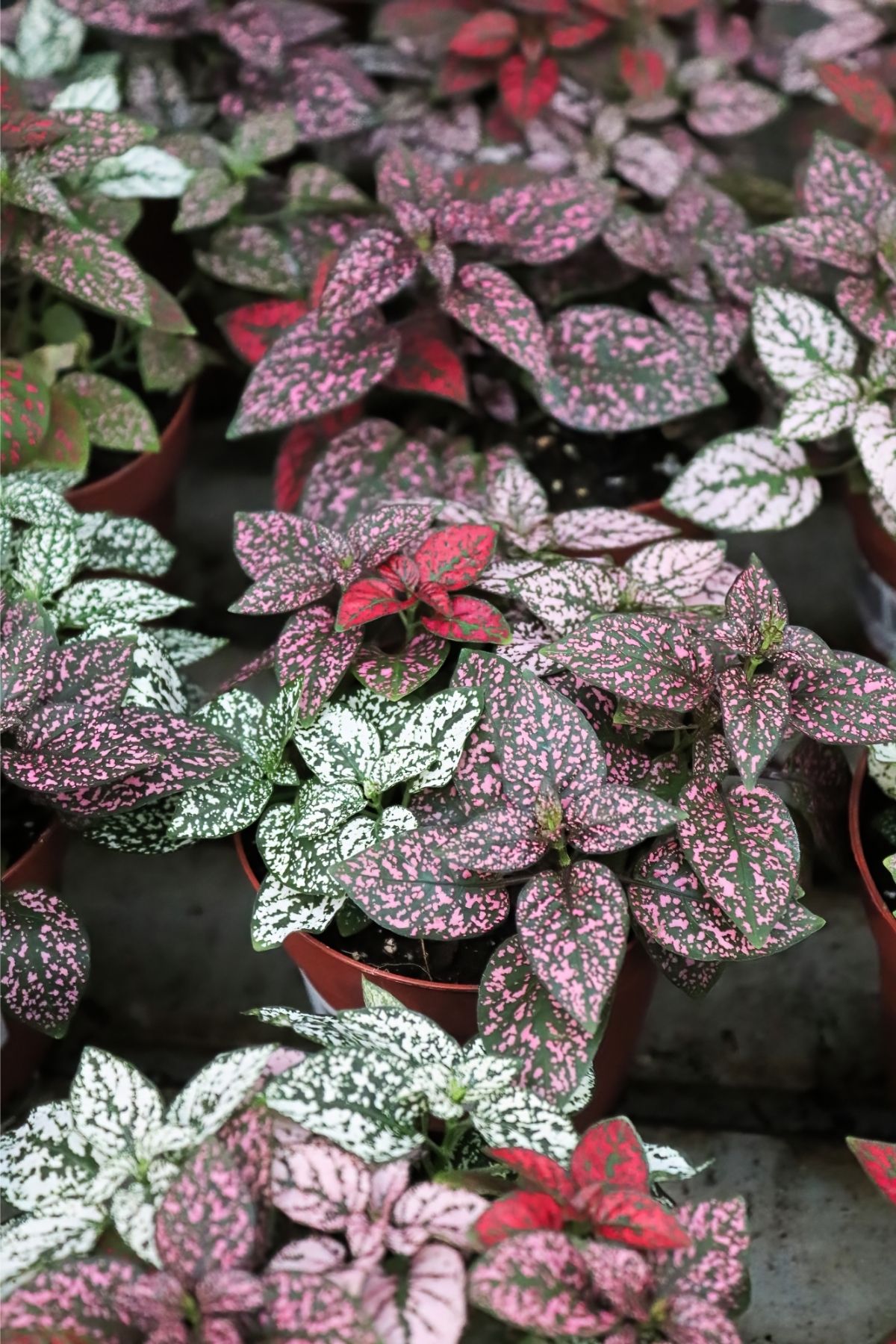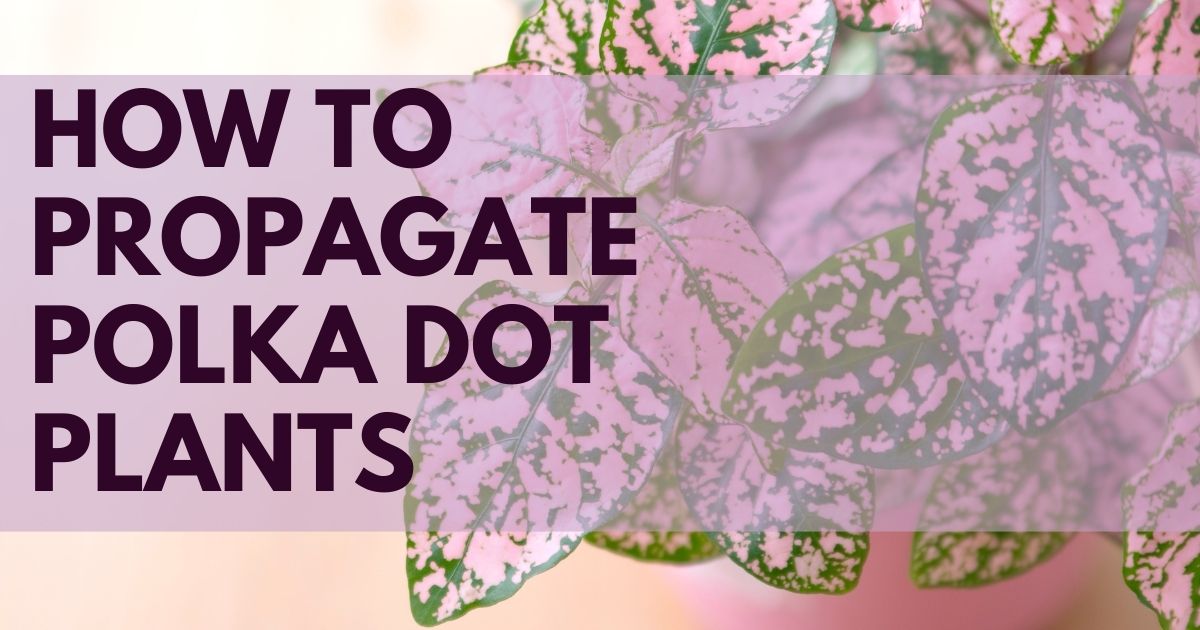What is a Polka Dot Plant?
This article will give us enough information on how to propagate Polka Dot Plants. Polka Dot Plants (Hypoestes phyllostachya) are the most colorful and unusual indoor plants. They are pretty simple to look after and even propagate.
This post will walk you through everything you need to know about propagating your Polka Dot Plant, including the equipment you’ll need, recognizing and handling problems as they arise, and answering your propagation questions.

How to Propagate Polka Dot Plants in Water
There are various ways of propagating Polka Dot Plants since it works for all stages of development. It’s also relatively simple to master because you may make multiple new Polka Dot Plants from a few tiny cuttings.
Locate Some Healthy Polka Dot Stems
For you to be sure of success when taking a vine cutting, make sure the part of the plant you’re cutting is healthy. It would be best to avoid any signs of illness or pests because they will transfer to your fresh cuttings, making it more difficult for them to grow into suitable plants.
When selecting cuttings to propagate your Polka Dot Plant, look for one thing in particular: nodes. The absence of nodes limits your chances of propagation success to none. We can define a node as a point on a specific stem where a leaf grows.
Make the Cut
Using sharp scissors, cut one or more stems. You should have at least two to three leaves on your cutting. This will ensure that you have a few good nodes from which roots can grow.
Keeping your instruments clean prevents bacteria or pests from spreading to your plant and is especially critical when working with poisonous plants. (Even though Polka Dot Plants are mostly non-toxic, it’s an excellent development habit.)
Fill up a Transparent Container with Water
You’ll need to cultivate your cuttings in something now that you’ve taken them. Polka Dot Plants grow roots quickly to put them directly into the soil. However, we usually recommend water as an intermediary step. It simply has a higher rate of success.
Fill your container halfway with warm water (to avoid shocking your delicate cuttings) and insert your cuttings in the bottom third of the container. Covering the cutting any longer raises the risk of it rotting.
If any leaves come into contact with the water, remove them immediately, as they will begin to rot after a few days underwater. When propagating, we usually use a clear container to see everything better.
Place Your Cuttings in Bright but Indirect Light
Place your glass indirect but bright light. Intense light will harm the cutting and prevent it from propagating successfully. You can use a light monitor to determine whether your Philodendron Birkin cuttings receive enough sunshine.
You may also use an LED grow light to supplement sunlight, which is lovely for stimulating cutting development. This one, available on Amazon, is one of our favorites. Finally, you may want to utilize the rooting hormone at this point. This will aid in the root development of fresh cuttings.
Change Out the Water Regularly
Refreshing the water is one of the most crucial procedures in the Polka Dot Plant multiplication process (every two to three days is optimal). This kills bacteria in the water and prevents it from stagnating, which is terrible for cutting. It’s preferable to avoid stagnant water because it will begin to smell.
Be patient
Fortunately, Polka Dot Plant cuttings grow roots quickly. After only a few days, you should see two delicate roots emerge from the node. However, it might be unpredictable, and some cuttings will develop faster than others. However, this process is more straightforward than some other typical houseplants, where you may have to wait months for anything to grow.
The advantage of Polka Dot Plants establishing roots so quickly is less time for something to go wrong, lowering the chance of root rot.
Plant Your Polka Dot Cuttings
It’s essential to plant your polka dot cuttings into the soil once the roots are a few centimeters long. Don’t worry if the roots are still fragile; this is common for Polka Dot Plants; be careful while potting them to avoid breaking them.
We recommend using a high-quality potting mix to ensure that your cuttings get the correct nutrients. This Miracle-Gro potting mix would be our first choice for soil. Place your cuttings a few millimeters into the earth with care. You can even replant the cuttings into the mother plant to make it fuller — the choice is yours!
Resume Usual Polka Dot Plant Care
You can resume your regular Polka Dot Plant care routine now that you have potted your cuttings into the soil. Those plants will soon be large enough to multiply again, leaving you with much more Polka Dot Plants than you could ever need.
Propagating Hypoestes Phyllostacha in Soil
The soil method starts the same way as the water method, which means you’ll need to get some stem cuttings first. Then, it’s time to prepare the pots once they’re ready to leave. Again, standard nursery plastic planters work great!
When making a mix, you don’t have to be too sophisticated. A Polka Dot Plant will thrive in coarse soil like a cactus mix. You can also use regular houseplant soil, although you might want to add some perlite to keep the combination light and airy.
Whatever combination you use, make sure it’s well-draining so your stem cuttings don’t sit in water. To avoid root rot, which can swiftly destroy a houseplant, water must be free to flow out of the container. After prepping your pots, gently poke your stem cuttings into the soil, and you’re ready to go! It is advisable to keep the soil moist but not saturated.
The disadvantage of adopting the soil approach is that you won’t be able to see the roots grow; thus, determining whether there are new roots or not can be a guessing game. After a few weeks, give the cuttings a gentle twist if you’re not sure. Do you encounter any opposition? Congratulations, the roots are still clinging on!
Polka Dot Plant Color Varieties
Polka Dot Plants are native to Central and South America. They belong to Gesneriaceae, containing about 150 genera and 3,600 species of mostly tropical herbs and shrubs. Polka Dot Plants are grown for their beautiful foliage in various colors.
The most common Polka Dot Plant colors are white and pink hypoestes, but you can find them in shades of red, orange, yellow, green, and purple. Polka Dot Plants are relatively easy to care for and make excellent houseplants. With proper care, they will thrive for many years. If you are looking for a plant that is both beautiful and easy to care for, the polka dot is the best.

How to Care for Hypoestes Phyllostacha
After you’ve successfully produced Polka Dot Plants, it’s time to learn the fundamentals of what they require to survive and develop! Fortunately, these popular houseplants are not challenging to grow.
Light
The beautiful variegated leaves of Polka Dot Plants are well-known. If you want the best lovely pink, silver, or red patches, make sure your plants get plenty of light. The variegation will fade away in direct sunshine without being bright enough, and your plant will begin to become leggy. Intense yet indirect light is ideal, such as that found on a sunny windowsill.
Temperature
Polka plants are tropical plants native to Madagascar and South Africa. As a result, they do not thrive in a cold environment. If you’re out, your plants are probably feeling the same way!
Polka Dot Plants thrive in temperatures between 70 and 80 degrees Fahrenheit (21 to 26 degrees Celsius). However, these plants may not succeed if the room temperature falls into the 50s (low teens in Celsius) as it would in a garage. Read our article and find out What Temperature Is Too Cold For Plants.
Humidity
Although Polka Dot Plants do not require a humid atmosphere, they prefer a humidity level of 50% or more. This may not always be possible. It depends on where you live, but there are some small things you can do to assist your plants.
You have the option of putting your plants in the bathroom where there is high humidity. This will work best if you have a window in your bathroom! You can also use a humidifier.
Soil
As previously stated, Polka Dot Plants aren’t fussy about their soil, but it does need to be well-draining and nutrient-rich. A combination of ordinary potting soil and a handful of perlite should be sufficient. In addition, it is advisable to add a handful of compost or worm castings to any mix for a nutritional boost that your plants will benefit from.
Watering
When it comes to Polka Dot Plant watering, keep the soil mildly damp but not waterlogged. Exactly like most tropical houseplants!
In most cases, you may need to water your plants once or twice a week. This, however, fluctuates dramatically depending on how dry or warm your residence is during different times of the year.
Make it a practice to check if your Polka Dot Plants need a top-off twice a week. Dipping your finger into the soil is the easiest to inspect. You can forego watering that day if the soil seems damp.
Fertilizing
Like many other houseplants, Polka Dot Plants benefit from extra fertilizers during the growing season (spring and summer). Once a month, apply a diluted general fertilizer to encourage new growth.
When you have houseplants like the Polka Dot Plant that aren’t actively growing in the fall and winter, you shouldn’t fertilize them.
Our Polka Dot Plants Toxic to Domestic Animals?
Fortunately, Polka Dot Plants are not poisonous to cats and dogs, according to the ASPCA. While this is terrific news for pet owners, keep your plants out of harm’s way. Those vibrant leaves might be rather tempting!
Why is Hypoestes Phyllostacha Propagated?
Before we get into the nitty-gritty of Polka Dot Plant propagation, you might be wondering why it’s beneficial to propagate a Polka Dot Plant in the first place? Well, here are some of the main reasons:
Create More Polka Dot Plants
Propagating your Polka Dot Plant will multiply your plant collection without needing to spend any more money! They also make great gifts for friends and family if you already have enough houseplants.
Save a Dying Polka Dot Plant
If you accidentally overwatered (which is easy to do), over-fertilized, or mistreated your Polka Dot Plants and it has started to die, sometimes the best way to save them is by taking the healthy stems and propagating them to create new healthy plants before it’s too late.
To Make Polka Dot Plants Fit Their Environment
Polka Dot Plants can grow pretty quickly in the right environment, and they can slowly outgrow their pot or spot in your home. Giving them a trim is a great way to cut back some of the growth, and propagating those Polka Dot Plant stems is a great way to stop them from going to waste.
Propagation Tools for Polka Dot Plants
Before you take any cuttings, be sure you have everything you need.
- Mature and healthy Polka Dot Plant
- Sharp, clean scissors/shears
- Pot(s) with and without drainage holes in reserve
- Water and fresh soil
- If you’re propagating indoors, use a newspaper or a plastic sheet
- Rooting hormone (optional)
- Gardening gloves (optional)
Common Issues Experienced When Propagating Hypoestes Phyllostacha
Propagating plants doesn’t always have 100% success, and you may encounter some problems. For example, one of the most common issues you may experience when propagating Hypoestes phyllostacha is that the polka dot flowers fade quickly.
You can avoid this by using a sharp knife to carefully remove the faded flowers from the plant. Another common issue is that the leaves may be yellow and drop off if the soil is too dry. To avoid this, make sure to water the plant regularly and keep the soil moist. If you notice any other problems with your plant, such as pests or diseases, consult a professional for help.
FAQs on Polka Dot Plant Propagation
How Long Will it Take my Plant Cuttings to Bloom?
It can take Polka Dot Plant cuttings anywhere from a few weeks to a few months to bloom. The time your plant cuttings will take to bloom depends on the conditions where the cutting is being grown and the type of Polka Dot Plant.
Some Polka Dot Plants are faster-growing than others, so it’s essential to research the variety you have to figure out how long it typically takes for cuttings to bloom. Generally speaking, Polka Dot Plant cuttings will bloom faster in warmer, more humid conditions. But, if you’re patient, you’ll get a reward for the beautiful polka dot blooms in no time!
Which Soil Should I Use for Polka Dot Plant Propagation?
There are a few things to consider when choosing soil for Polka Dot Plant propagation. Drainage, aeration, and pH levels are important factors to keep in mind. A well-draining potting mix is ideal, as Polka Dot Plants do not like to sit in wet conditions. Adding perlite or pumice can help improve drainage.
You should also aerate the soil to allow for adequate oxygen exchange. A general guideline is to use a mix of two parts peat moss to one part perlite. As for pH levels, Polka Dot Plants prefer slightly acidic conditions with a pH range of 6.0-6.5. To achieve the desired pH level, you can amend the soil with compost or organic matter.
Should I Use a Grow Light for my Hypoestes Phyllostacha Cuttings?
Suppose you’re thinking of propagating Polka Dot Plant (Hypoestes Phyllostacha) cuttings. In that case, you may be wondering if you need to use a grow light. The answer is maybe! If you’re growing a Polka Dot Plant in a low-light environment, using a grow light will help your cutting thrive.
However, if you’re growing a Polka Dot Plant in a sunny location, a grow light may not be necessary. Ultimately, it’s up to you to decide whether or not using a grow light is suitable for your particular situation.
Does Polka Dot Plant Cuttings Require Fertilization?
No, Polka Dot Plant cuttings do not require fertilization. They are a straightforward plant to propagate and do well in most indoor conditions. Polka Dot Plants tolerate low light levels but will produce more leaves if given brighter light.
Water when the soil surface begins to dry out, about once a week. These plants do not like to be wet or soggy. Allow the Polka Dot Plant to go almost dry between watering. Fertilize monthly with a balanced houseplant fertilizer diluted by half during the growing season. Cut back on watering and fertilizer in the fall and winter months.
What is a Node?
Nodes are points along a stem where leaves and branches originate. For example, in the Polka Dot Plant, nodes are what give the plant its distinctive polka dot pattern. The dots are tiny buds that can grow into new leaves or branches. Nodes are also where flowers and fruits form.
Can I Propagate a Hypoestes Phyllostacha from a Single Leaf?
Polka Dot Plants are relatively easy to propagate from a single leaf. Cut a leaf off the plant, ensuring a bit of stem is attached. Place the leaf in water and wait for it to develop roots. Once it has roots, you can transplant them into the soil.

The Final Bloom!
We hope you find this Polka Dot Plant propagation guide helpful. Of course, it can be a little unexpected whether or not it will succeed. Still, it is far easier than propagating some other houseplant types, so we are confident you will have Polka Dot Plants sprouting everywhere in no time!!
Now that you know how to propagate Polka Dot Plants, it’s time to get started. Be sure to follow the tips we outlined to have the best chance of success. With a little bit of patience and care, you should be able to grow your very own Polka Dot Plant from a single leaf. Enjoy!
